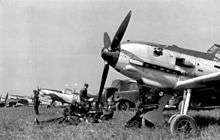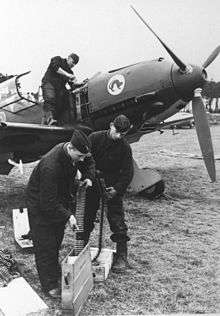Jagdgeschwader 51
Jagdgeschwader 51 (JG 51) was a German fighter wing during World War II. JG 51's pilots won more awards than any other fighter wing of the Luftwaffe, and operated in all major theatres of war. Its members included Anton Hafner, Heinz Bär, Karl-Gottfried Nordmann, and Günther Schack.
| Jagdgeschwader 51 | |
|---|---|
 Unit insignia | |
| Active | 1939–45 |
| Country | |
| Branch | |
| Type | Fighter Aircraft |
| Role | Air superiority |
| Size | Air Force Wing |
| Nickname(s) | Mölders |
| Patron | Werner Mölders |
| Commanders | |
| Notable commanders | Theo Osterkamp Heinz Lange |
World War II
Formed in August 1939 and commanded by Theo Osterkamp, JG 51 was based in the early months of the war in the West, fighting in the Battle of France and the Battle of Britain. From late June 1940 to mid July 1940, JG 51 was the only fighter Geschwader engaged continuously against the RAF. During the battle JG 51 lost 68 pilots, the highest casualty rate of the Luftwaffe fighter units engaged.

From 12 July 1940 until November 1940, Stab JG 51 was located at Saint-Inglevert Airfield in Saint-Inglevert, France.[1] Major Werner Mölders became the unit's commander in July 1940 and led the unit during the invasion of the Soviet Union in June 1941.
During Operation Barbarossa, JG 51 was positioned in the centre of the 4,480 km-long front. Its task was to support Panzer Group 2, which formed the right flank of Army Group Centre, advancing northeast towards Moscow. After achieving more than 100 victories (the first time an aviator ever had done so), Mölders was forced to stop flying (for propaganda reasons) and was made an inspector of fighter aircraft. After Mölders's departure in September 1941 and death later that year, the unit adopted his name in early 1942. The unit remained on the centre sector of the Eastern Front throughout the rest of 1941. In the period 22 June - 5 December 1941 the unit destroyed 1,881 Soviet aircraft against 84 losses in aerial combat and a single aircraft on the ground.[2]
General Wolfram Freiherr von Richthofen's 8th Air Corps was in charge of air support for the Wehrmacht's Army Group Centre. In early January 1942, among the fighter units available to Richthofen were Gruppe II., III., and IV. / JG 51. With the onset of the sub-zero winter conditions, the majority of JG 51's available aircraft were grounded.

Most of early 1942 was spent in defensive missions against counter-attacks on Army Group Center's left flank. Its situation had by now stabilised after severe losses in personnel and materiel. Night bomber attacks during June 1942 put a part of JG 51's aircraft out of commission on the airfields at Oryol, Bryansk and Dugino (west of Kursk). In August 1942, JG 51 suffered heavier losses than anything previously during the conflict; 101 Bf 109s were destroyed or written off from all causes during the month, with 17 pilots killed, missing, or hospitalized.
In November 1942, II. / JG 51 was transferred to the Mediterranean theatre, fighting over Tunisia, Sicily and Italy before leaving for Sardinia in April 1943. 3. / JG 1 were also transferred in, and subordinated to II. Gruppe as 6. Staffel.[3] The unit handed over its remaining aircraft to JG 77 and left the continent on 19 April 1943. The unit had lost 26 pilots killed, almost a 100% loss rate since their arrival.[4] In July, the unit flew from Trapani against the American forces in Sicily. In March 1944, it moved to Yugoslavia and the Balkans in order to cover the Ploiești oil fields.
Later in 1943 II. Gruppe was part of the German efforts to thwart the USAAF bomber offensive by 15th Air Force. It was stationed at various times in Hungary, Greece and Austria until late 1944. During the Battle of Kursk in southern Russia, Gruppe I., III., and IV. / JG 51 were based at Oryol with Luftflotte 6, flying in support of Army Group Centre. On 5 July 1943, the Soviet forces launched concentrated air attacks against the German airfields, and as all available Luftflotte 4 and 6 fighters scrambled, one of the largest air battles in history began. As Germany was losing the war, JG 51 retreated together with the rest of the Wehrmacht and by May 1945 operated out of East Prussia.
Commanding officers
Given below is a list of commanding officers of JG 51.
| • Oberst Theo Osterkamp | 19 September 1939 | – | July 1940[5] |
| • Oberstleutnant Werner Mölders | 27 July 1940 | – | 19 July 1941[5] |
| • Oberst Theo Osterkamp (acting) | 28 July 1940 | – | 7 August 1940 |
| • Oberstleutnant Friedrich Beckh | 19 July 1941 | – | 10 April 1942[5] |
| • Major Günther Lützow (acting) | September 1941 | – | 8 November 1941 |
| • Oberstleutnant Karl-Gottfried Nordmann | 10 April 1942 | – | 30 March 1944[5] |
| • Major Fritz Losigkeit | 1 April 1944 | – | 31 March 1945[5] |
| • Major Heinz Lange | 2 April 1945 | – | disbandment[5] |
References
Citations
- "Saint-Inglevert" (in French). Old Anciens Aerodromes. Retrieved 18 March 2011.
- Bergström 2007, p. 116.
- Weal 2006, p. 95.
- Weal 2006.
- Aders & Held 1993, p. 247.
Bibliography
- Aders, Gebhard; Held, Werner (1993). Jagdgeschwader 51 'Mölders' Eine Chronik – Berichte – Erlebnisse – Dokumente [Fighter Wing 51 'Mölders' A Chronicle - Reports - Experiences - Documents] (in German). Stuttgart, Germany: Motorbuch Verlag. ISBN 978-3-613-01045-1.CS1 maint: ref=harv (link)
- Bergström, Christer (2007). Barbarossa—The Air Battle: July–December 1941. Hersham, Surrey: Classic Publications. ISBN 978-1-85780-270-2.CS1 maint: ref=harv (link)
- Weal, John (2006). Jagdgeschwader 51 "Mölders". Oxford, UK: Osprey Publishing. ISBN 978-1-84603-045-1.CS1 maint: ref=harv (link)